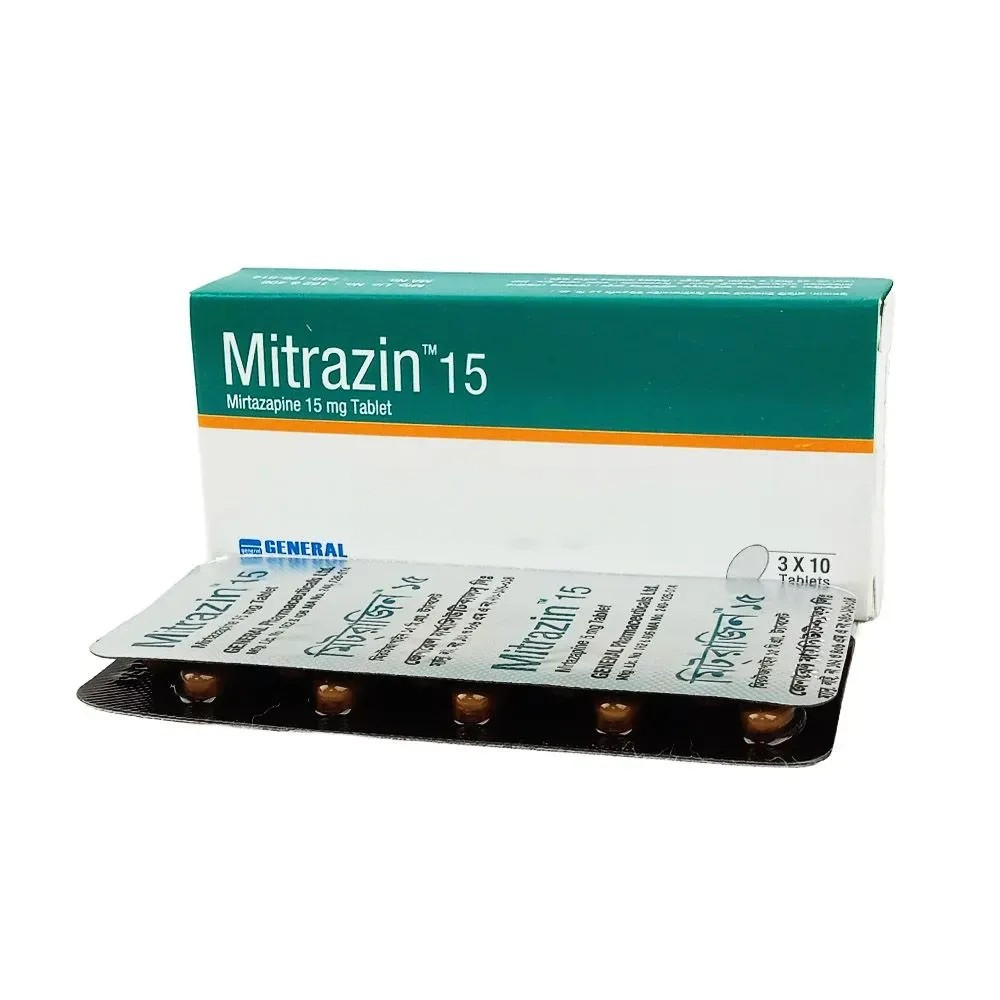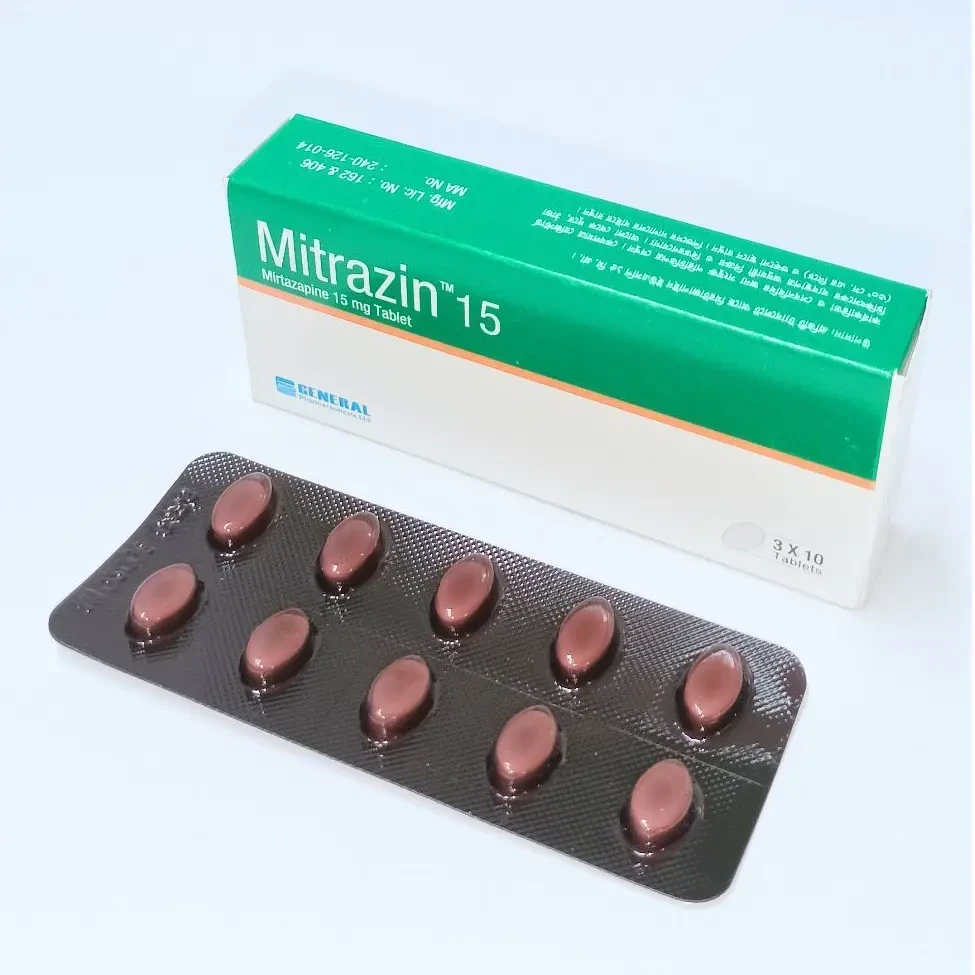Unit Price:
৳ 9.00
(3 x 10: ৳ 270.00)
Strip Price:
৳ 90.00
Also available as:
Indications
Mitrazin Tablets are indicated for the treatment of major depressive disorder (MDD).
Pharmacology
Pharmacodynamics: The mechanism of action of Mirtazapine as with other drugs effective in the treatment of major depressive disorder is unknown. Evidence gathered in preclinical studies suggests that Mirtazapine enhances central noradrenergic and serotonergic activity. These studies have shown that Mirtazapine acts as an antagonist at central presynaptic α2-adrenergic inhibitory autoreceptors and heteroreceptors, an action that is postulated to result in an increase in central noradrenergic and serotonergic activity. Mirtazapine is a potent antagonist of 5- HT2 and 5-HT3 receptors. Mirtazapine has no significant affinity for the 5-HT1A and 5-HT1B receptors. Mirtazapine is a potent antagonist of histamine (H1) receptors, a property that may explain its prominent sedative effects. Mirtazapine is a moderate peripheral α1-adrenergic antagonist, a property that may explain the occasional orthostatic hypotension reported in association with its use. Mirtazapine is a moderate antagonist at muscarinic receptors, a property that may explain the relatively low incidence of anticholinergic side effects associated with its use.
Pharmacokinetics: After oral administration of Mirtazapine tablets, the active constituent mirtazapine is rapidly and well-absorbed, reaching peak plasma levels after about 2 hours. Binding of mirtazapine to plasma proteins is approximately 85%. The mean half-life of elimination is 20-40 hours; (26 hours in males, 37 hours in females). The half-life of elimination is sufficient to justify once-a-day dosing. Mirtazapine displays linear pharmacokinetics within the recommended dose range. Mirtazapine is extensively metabolized and eliminated via the urine and faeces four days. Major pathways of biotransformation are demethylation and oxidation followed by conjugation.
Pharmacokinetics: After oral administration of Mirtazapine tablets, the active constituent mirtazapine is rapidly and well-absorbed, reaching peak plasma levels after about 2 hours. Binding of mirtazapine to plasma proteins is approximately 85%. The mean half-life of elimination is 20-40 hours; (26 hours in males, 37 hours in females). The half-life of elimination is sufficient to justify once-a-day dosing. Mirtazapine displays linear pharmacokinetics within the recommended dose range. Mirtazapine is extensively metabolized and eliminated via the urine and faeces four days. Major pathways of biotransformation are demethylation and oxidation followed by conjugation.
Dosage & Administration
Adult dose: The recommended starting dose for Mirtazapine tablets is 15 mg/day, administered in a single dose, preferably in the evening or prior to sleep. The effective dose range was generally 15 to 45 mg/day and the patients not responding to the initial 15 mg dose may benefit from dose increases up to a 30 mg to maximum of 45 mg/day. Mirtazapine has an elimination half-life of approximately 20 to 40 hours; therefore, dose changes should be made at intervals of less than 1 to 2 weeks in order to allow sufficient time for the therapeutic response to a given dose.
Use in children: Use in children are not recommended to Mirtazapine.
Missed Dose: If anyone misses a dose of mirtazapine, take it as soon as remember unless it is close to when the next dose is due. If anyone missed a dose of medication and it is close to the time of next dose, skip the missed dose and should take next dose at the regularly scheduled time. One should not take double or more than prescribed dose.
Use in children: Use in children are not recommended to Mirtazapine.
Missed Dose: If anyone misses a dose of mirtazapine, take it as soon as remember unless it is close to when the next dose is due. If anyone missed a dose of medication and it is close to the time of next dose, skip the missed dose and should take next dose at the regularly scheduled time. One should not take double or more than prescribed dose.
Interaction
Mitrazin has clinically significant drug-drug interactions with Monoamine Oxidase Inhibitors (MAOI) & other serotonergic drugs such as tryptophan, triptans, linezolid, serotonin reuptake inhibitors, venlafaxine, lithium, tramadol, or St. John's wort. Mitrazin may interrupt the metabolism or activity of Carbamazepine, Phenytoin or Cimetidine. Patient should avoid Alcohol & Diazepam while taking Mitrazin.
Contraindications
Hypersensitivity: Mirtazapine is contraindicated in patients with a known hypersensitivity to Mirtazapine or to any of the excipients.
Monoamine Oxidase Inhibitors: The concomitant use of Mirtazapine and a monoamine oxidase (MAO) inhibitor is contraindicated. Mirtazapine should not be used within 14 days of initiating or discontinuing therapy with a monoamine oxidase inhibitor (MAOI).
Monoamine Oxidase Inhibitors: The concomitant use of Mirtazapine and a monoamine oxidase (MAO) inhibitor is contraindicated. Mirtazapine should not be used within 14 days of initiating or discontinuing therapy with a monoamine oxidase inhibitor (MAOI).
Side Effects
The most common side effects of Mitrazin are dizziness, drowsiness, dry mouth, increased appetite, weight gain etc.
Pregnancy & Lactation
Pregnancy Category-C. Patients should be advised to notify their physician if they become pregnant or intend to become pregnant during Mirtazapine therapy. Patients should be advised to notify their physician if they are breastfeeding an infant.
Precautions & Warnings
Patients, their families, and their caregivers should be encouraged to be alert to the emergence of anxiety, agitation, panic attacks, insomnia, irritability, hostility, aggressiveness, impulsivity, akathisia (psychomotor restlessness), hypomania, mania, other unusual changes in behavior, worsening of depression, and suicidal ideation, especially early during antidepressant treatment and when the dose is adjusted up or down. Patients who are to receive Mitrazin should be warned about the risk of developing agranulocytosis. Mitrazin may impair judgment, thinking, and particularly, motor skills, because of its prominent sedative effect. Clinically significant ALT (SGPT) elevations (≥3 times the upper limit of the normal range) may occur.
Therapeutic Class
Atypical anti-depressant drugs
Storage Conditions
Keep away from light and moisture. Store below 30º C. Keep all medicine out of the reach of children.
Pack Images: Mitrazin 15 mg Tablet



